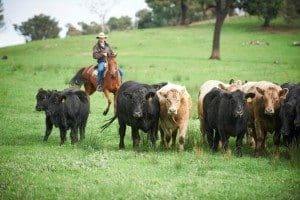AUSTRALIA’S red meat industry can become carbon neutral by 2030, Meat & Livestock Australia managing director Richard Norton told the company’s annual general meeting in Alice Springs this afternoon.
Mr Norton said achieving the goal would put Australia head and shoulders above its competitors, giving consumers even more confidence in the quality and integrity of Australian red meat and turning environmental criticism of the industry on its head.

He said Australian red meat’s reputation was second to none amongst global consumers, but the industry must keep focus on changing consumer demands and act on emerging threats and market disruptors to prosper into the future.
“With industry commitment, the right policy settings and new investment in research, development and adoption, the Australian red meat industry can be carbon neutral by 2030,” Mr Norton said.
“And we can be the first red meat exporting nation to do so.”
To this end, Mr Norton announced that MLA had initiated a project with CSIRO (details below) to identify pathways for the red meat industry, farm and processing sector included, to become carbon neutral.
The project has identified a series of innovation and farm management options including the expanded use of legumes and dung beetles in pastures, savannah fire management in northern Australia, feed supplements, lotfeeding and vegetation management. Genetic selection and a potential vaccine to reduce methane production in the rumen were other opportunities, he said.
“These pathways don’t require the heavy hand of regulation,” Mr Norton said.
“What they do require is the commitment of industry, the right policy settings from federal and state governments, and a continued investment in research, development and adoption of innovation within industry.”
He said the dividends from setting a carbon neutral goal would include:
- increased productivity in the red meat industry,
- additional farm income from carbon mitigation projects,
- a major contribution to government targets on emissions reduction, and
- another strong assurance for consumers of the quality and integrity of our naturally produced, great tasting Australian red meat.

Richard Norton
Mr Norton reported that MLA was gathering more consumer insights from export markets than ever before, which was directly informing where and how MLA invested the industry’s marketing levy.
“There are clear market signals in our high value international markets that emissions from livestock production are an issue for consumers who are also increasingly interested in the provenance of their food,” he said.
“At the same time, global companies and billionaire entrepreneurs are investing big dollars in projects to manufacture cultured and synthetic beef to try and lay claim to having zero environmental and welfare impact.”
“There are other signals as well. Both sides of federal parliament have committed to further reduce national carbon emissions by 2030 and most state governments have set carbon neutral targets.”
Mr Norton said the Australian red meat industry had already done much of the heavy lifting in the reduction of Australia’s total emissions to date and had an opportunity to create an even better story about its product in the years ahead.
“MLA now believes our industry can achieve a carbon neutral goal, while driving productivity gains and further differentiating Australian red meat from low cost competitors and artificial alternatives”
“The red meat industry has already reduced its share of Australia’s total emissions from 20 percent of Australia’s 600 million tonnes total emissions in 2005 to just 13pc in 2015, while also helping to reduce Australia’s overall emissions to 525 million tonnes over the same period,” Mr Norton said.
“Further demonstration of our industry’s willingness to engage is the beef industry’s commitment to reducing emissions by nominating ‘managing climate risk and ‘the balance of tree and grass cover’ as two of the six key priority areas within its Sustainability Framework.
“MLA now believes our industry can achieve a carbon neutral goal, while driving productivity gains and further differentiating Australian red meat from low cost competitors and artificial alternatives.
“This will ensure Australian red meat remains the natural choice in the high value international markets that reward quality, product integrity and ethically and environmentally sustainable production systems.”
About the project: ‘A Carbon Neutral Red Meat Industry’
This MLA-commissioned project conducted by CSIRO will look into how the red meat industry could become carbon neutral by 2030. Becoming carbon neutral means the industry (defined as the farm and processor sectors) captures or removes carbon from the atmosphere, at the farm and processing levels, as recorded annually by the Australian Government. The process for the project has been:
- Collaboration with the Australian Department of the Environment and Energy to establish the 2005 industry baseline in alignment with federal government emission baselines.
- Establish contributions from the beef, sheep grazing, feedlot and processing sectors to overall industry greenhouse gas emissions (GHG).
- Assume national herd numbers of 28 million cattle and 70 million sheep (10 year averages).
- Explore options for reducing GHG emissions from animals, processing and carbon capture from trees and soil and then quantify their impacts (applicability, practicality and cost effectiveness).
- Identify pathways based on various combinations of these practices to gain carbon neutrality by 2030.
- Determine what research, development and adoption is needed for the industry to achieve this target, along with associated financial returns in productivity gains and potential carbon credits.
The final report will be published next month.
- More reports from today’s red meat AGMs in Alice Springs tomorrow

Watch this space, it won’t be consumers and retailers who pay for this pathway. They haven’t ever picked up the cost of their “demands” and that I believe will not change in any real way. More costs to be sheeted back to producers and because they are already in front, that is where the fat is seen to be. Carbon capture in production systems goes down the gurgler every drought when soil carbon building materials are in very short supply. The time to regenerate is longer than the interval between droughts and the carbon take off via animals/ produce is always there in the better seasons. Carbon Offsets only work in improving soil carbon in the areas where the offset environment is located and often involve growing trees to tie up atmospheric carbon, not really improve soil carbon. People conveniently forget the impact that trees have on water permeability and the availability of runoff. Treed environments reduce water availability in ecosystems. Environmental soil carbon improvement in the production area may never significantly change for the better but everyone runs around saying that they are operating sustainably. It’s like a business that makes a loss in one area but remains in balance overall because the value of an asset in another area rises and offsets the loss. At the end of the day the business is still unsuccessful and the assett is still physically exactly as it was before, but is mystically worth a lot more and saves the day. All forms of accounting systems for money have the capacity to make a story the way you want to tell it. I fear the same is inherent in carbon accounting systems as well. The only way to honestly improve carbon capture in soil based production systems is to do it at the site of production. Offsets are smoke and mirrors, give a warm fuzzy feeling that can be used to market an idea that may in fact have little substance in terms of real outcomes for the environment where animals are living. One wild fire in an offset tree plantation releases years of carbon capture back into the system and wipes out that carbon credit as an asset. When it disappears honest management of the use of this offset would require all of those who have been utilising the pathway to return the monetary benefit they have generated because the basis upon which that money has been claimed is no longer able to be substantiated and the so called sustainability of the arrangement is lost. In fact it becomes an additional carbon footprint increase which should attract financial penalty for the offset arrangement parties. However it seems to be a way to make a few bob out of thin air.
Closing the loop on methane – with methane oxidising soil bacteria.
Work done in Florida on landfill methane indicates we may be missing a very big piece of this methane story – Nature does not do “waste”.
There are bacteria that live in the soil beneath the feet of our cattle and sheep that feed on methane. These bacteria use methane as their “feed source” and convert it back to CO2. So their work below ground can balance the work of the rumen bacteria above ground. (They basically eat the cows methane.)
I asked the lead scientist on the Florida research this question – Is it possible that by changing grazing management we can improve conditions below ground and boost numbers of these “methane eating” bacteria enough to not just make the whole system methane neutral, but maybe even a net GHG sink rather than a source?
His answer – “You have plenty of room to improve conditions, and the amount you need to improve them should be attainable.” – (This is how a cautious scientist says Yes.)
We need to conduct some serious research on this aspect of the methane cycle.
The Producers are already in front when it comes to Greenhouse and Carbon in Soil issue and are therefore positive for carbon footprint … so maybe the solution might be for the down-stream players to buy carbon credits from their customers; either directly, or in a market-place … everyone wins.